On Monday, in
response to a request for assistance from Texas Governor Greg
Abbott, Ohio Governor Mike DeWine has authorized a contingent from
the Ohio State Highway Patrol (OSHP) to respond to Texas to assist
local law enforcement with border surveillance.
A total of 14 OSHP troopers and supervisors will travel to Texas.
During this two-week assignment, the OSHP will not be tasked with
making arrests.
Last week, Governor DeWine approved the deployment of 185 members
of the Ohio Army National Guard to Texas to provide non-law
enforcement support to the United States Custom and Border
Protection. The activation was made at the request of the U.S.
Department of Homeland Security (DHS) and the National Guard Bureau
(NGB). The service members will be deployed on federal Title 10
status in late 2021.
Approximately 115 members of the Ohio National Guard's 1484th
Transportation Company were previously deployed to support the
Southwest Border operations at the request of DHS and NGB. These
Soldiers currently remain on active duty.
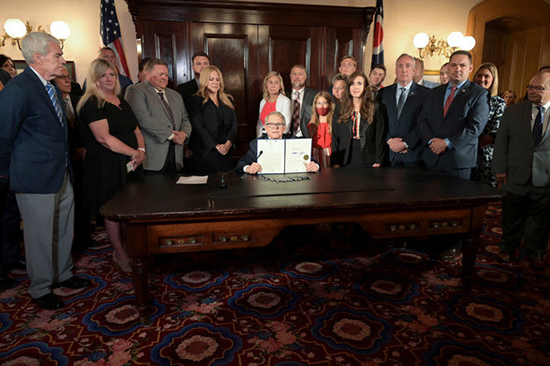
Governor DeWine holds up SB 126 after
signing on Tuesday.
On Tuesday, Governor DeWine signed Senate Bill 126 into law, also
known as Collin's Law. Collin's Law is Ohio's Anti Hazing Act,
enacting a number of changes intended to end hazing and any cultural
issues that allow hazing to persist.
"Simply put - we cannot tolerate hazing," said Governor DeWine in
his remarks before signing the bill. "I believe Collin's Law will
help change the culture surrounding hazing and save lives."
Collin's Law makes a number of changes, including but not limited
to:
* Expands the definition of hazing and specifies that hazing may
include “coercing another to consume alcohol or a drug of abuse."
* Increases the penalty for hazing to a 2nd degree misdemeanor.
* Expands the list of officials required to report hazing.
* Widens the scope of those who can be punished for participating in
or permitting hazing. (A violation that results in serious harm is a
3rd degree felony.)
* Requires that those aware of hazing report it to authorities, with
penalties up to a 1st degree misdemeanor for failing to do so.
* Requires the Ohio Department of Higher Education to implement a
statewide anti-hazing plan.
* Requires staff and volunteers at colleges and universities to
undergo training on hazing awareness and prevention.
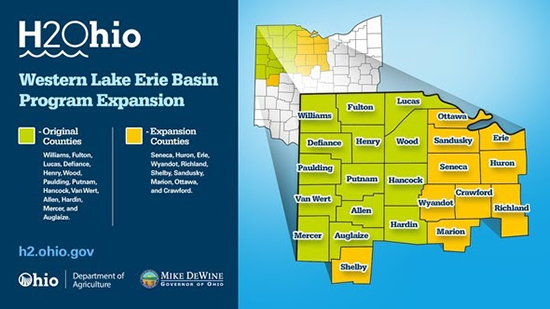
Governor DeWine was joined at the bill signing by the parents and
family of both Collin Wiant, for whom the bill is named, and Stone
Foltz. Wiant and Foltz both died as the result of hazing at seperate
incidents at Ohio universities.
Collin's Law will be effective in 90 days.
Also on Tuesday, Governor DeWine and Ohio Department of Agriculture
(ODA) Director Dorothy Pelanda announced that H2Ohio's farmer
incentive program is expanding into 10 additional counties in the
Western Lake Erie Basin.
The program, which offers funding to farmers who implement proven
conservation practices that limit agricultural phosphorus runoff
from fertilizer, is now open to farmers in Seneca, Huron, Erie,
Wyandot, Richland, Shelby, Sandusky, Marion, Ottawa, and Crawford
counties, bringing the total number of counties eligible for the
program to 24. Phosphorus runoff is the primary factor behind algal
blooms on Lake Erie.
"Our food growers and producers in the Western Lake Erie Basin want
to be part of the solution, as evidenced by the 1,800 farmers who
participated in the program's first year," said Governor DeWine. "By
expanding H2Ohio's farmer incentive program into more counties in
the area, we'll continue to slow phosphorus runoff, which will
ultimately contribute to a reduction in Lake Erie algal blooms over
the long term."
Ohio's new bipartisan operating budget, passed by the Ohio General
Assembly and signed by Governor DeWine last week, provides $120
million over the next two years to continue and expand funding to
farmers who work to reduce phosphorus runoff.
Farmers in the original 14 participating counties, including
Williams, Fulton, Lucas, Defiance, Henry, Wood, Paulding, Putnam,
Hancock, Van Wert, Allen, Hardin, Mercer, and Auglaize, will
continue receiving incentives during the program's second year and
have already enrolled more than one million acres of cropland in the
program.
“We are excited to not only move forward with these important
conservation practices in our original target area of the Western
Lake Erie Basin but also be able to incorporate these practices into
an even greater area,” said ODA Director Dorothy Pelanda “Interest
is incredibly strong and ODA is committed to working with our
farmers to help them navigate the process of conserving their water
and land resources while advancing water quality in our state.”
Virtual meetings will be held later this month for farmers in the
newly eligible counties to provide more information on H2Ohio's
conservation programs. More information on these meetings is
available at h2.ohio.gov.
On Wednesday, Governor DeWine and First Lady Fran DeWine visited
the Toledo Museum of Art for the unveiling of the “Baby Dragon,” a
new portable glassblowing tool. The Toledo Museum of Art will use
the tool for demonstrations at the museum and out in the community.
Also on Wednesday, Governor DeWine and Ohio EPA Director Laurie A.
Stevenson announced that two dozen communities will receive a total
of $9 million in H2Ohio funding for projects to improve the quality
of drinking water and to repair or replace aging water, wastewater,
and sewage infrastructure.
"These projects will improve the quality of life for thousands of
Ohioans by giving them reliable access to clean water and by
addressing failing wastewater and home sewage treatment systems
which are also a threat to public health and the environment," said
Governor DeWine. "All of our communities deserve to have strong
water infrastructure, and I am committed to helping our local
partners with these costly improvement projects."

Water Infrastructure Projects - $7.4 Million
Thirteen H2Ohio drinking water and wastewater infrastructure
projects, identified on the map below, will receive a total of $7.4
million to improve water service for thousands of residents across
the state.
Projects include the construction of a new water treatment plant,
the replacement of aging water lines, and the installation of new
water lines and water mains. New wastewater infrastructure projects
will solve sewer system backups, extend sanitary sewers, and replace
failing household sewage treatment systems with new sewers. Projects
were selected based on the community’s economic needs and project
readiness.
“Governor DeWine’s H2Ohio initiative enables Ohio EPA to extend
available funding to help communities across the state address their
water and wastewater needs and replace failing home sewage treatment
systems,” said Director Stevenson. “We are using H2Ohio funding to
make a difference in these communities and in the lives of Ohioans.”
Home Sewage Treatment System Replacement Projects - $1.6 Million
It is estimated that approximately 31 percent of all household
sewage treatment systems in Ohio are experiencing some degree of
failure and are discharging untreated sewage that potentially
exposes citizens to harmful bacteria and pathogens.
A total of $1.6 million in H2Ohio funding will go to the counties
listed below to help low- to moderate-income households repair and
replace failing home sewage treatment systems. Each county will
receive $150,000 for the projects.
The $9 million in H2Ohio grant funding announced today is in
addition to a new water and sewer program announced by Governor
DeWine last week. More details about the new program, which will be
funded with $250 million from the American Rescue Plan Act, are
forthcoming.
On Thursday, Governor DeWine announced today that more than two
dozen local drug task forces in Ohio will receive RecoveryOhio grant
funding to support efforts that disrupt the drug trade and promote
substance use awareness, prevention, and recovery.
A total of $2 million in grants from Governor DeWine’s RecoveryOhio
Law Enforcement Fund will be awarded among 27 existing drug task
forces to intensify their efforts to identify high-level drug
traffickers, dismantle large drug trafficking organizations,
interrupt the flow of money and drugs from international cartels,
and prevent the sale of illegal narcotics to those suffering from
substance use disorder.
Grant funding will also be used to support the mission of Governor
DeWine’s RecoveryOhio initiative which aims to increase substance
use and mental health awareness, implement age-appropriate
prevention education in schools, connect those who need help with
treatment, and promote recovery.
“Local drug task forces are the first line of defense against the
traffickers who are putting drugs into the hands of those battling
addiction," said Governor DeWine. "This funding will provide vital
tools in the area of drug use prevention, education, and treatment
that will promote effective strategies to reduce the prevalence of
substance use disorders and overdoses."
Examples of programs that will be created or expanded with
RecoveryOhio Law Enforcement Fund grants include:
* Central Ohio Drug Enforcement Task Force ($35,859.30) in Licking,
Coshocton, Knox, Guernsey, Muskingum, and Perry counties will use
funds to reduce the availability of illegal narcotics in the
six-county region and to provide professional training and
information-sharing opportunities for the task force and community
partners in addiction and recovery.
* Hamilton County Heroin Task Force ($230,577.81) will use funds to
expand services offered by its Quick Response Team (QRT) of social
workers and counselors to include overdose hotspot outreach
partnerships and programs with social service agencies.
* Lawrence Drug & Major Crimes Task Force ($60,568.94) will use
funds to increase efforts in drug prevention and education as well
as treatment for substance abuse disorders.
* Multi-Area Narcotics (MAN) Unit ($18,371.25) in Defiance, Fulton,
Henry, Paulding, Putnam, and Williams counties will use funds to
provide training by MAN Unit officers for area law enforcement,
schools, county workers, retail personnel, community administrators,
and public agencies for awareness of local drug trends, heroin
abuse, and overdose and meth components.
* Westshore Enforcement Bureau ($42,981.62) in Cuyahoga County will
use funds to support the retention of a youth prevention specialist
and continue annual contracts with two separate prevention/education
agencies that provide training throughout the school year on
subjects such as leadership, anti-bullying, suicide, and drug
addiction prevention.
Governor DeWine established the RecoveryOhio Law Enforcement Fund
to provide existing drug task forces with additional resources to
intercept illegal drugs and enhance their role in substance use
awareness, prevention, and recovery. Funding for these grants was
awarded as part of the biennium budget approved by the Ohio General
Assembly for 2020-2021. The continuance of the fund was among
Governor DeWine's priority budget items for the new biennium, and
the Ohio General Assembly dedicated $5 million to the program over
the 2022-2023 budget year.
A full list of award recipients can be found at
www.governor.ohio.gov.
The program is being administered by the Ohio Office of Criminal
Justice Services.
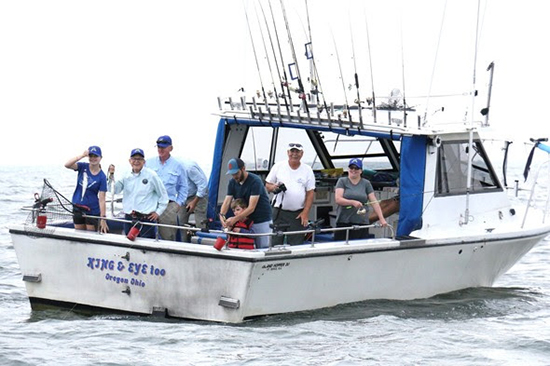
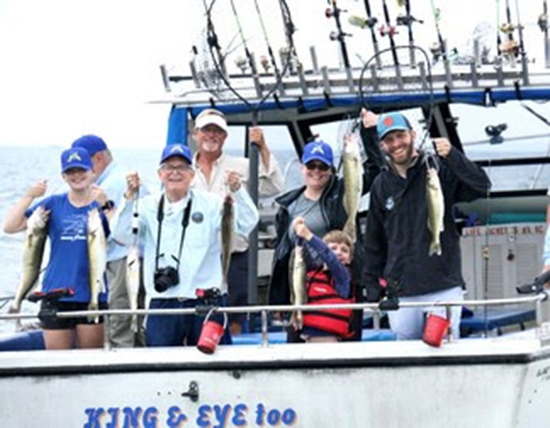
Governor DeWine out fishing with several family members at the
41st Fish Ohio Day.
Also on Thursday, Governor DeWine and Lt. Governor Jon Husted
highlighted the importance of protecting Lake Erie and the lake’s
fishery during the 41st Governor’s Fish Ohio Day. Governor DeWine
and Lt. Governor Husted were joined by Ohio Department of Natural
Resources (ODNR) Director Mary Mertz and other leaders from the
conservation community to commemorate the annual event.
The event is co-sponsored by the Lake Erie Charter Boat Association,
Lake Erie Shores & Islands, and the Ohio Department of Natural
Resources’ Division of Wildlife. Participants in the day’s
festivities enjoyed walleye fishing on Ohio’s Great Lake thanks to
19 licensed charter boat captains who donated their boats for use
during the event.
“Fish Ohio Day provides a great opportunity to experience the
world-class fishing on Lake Erie,” said Governor DeWine. “This also
gives us a chance to highlight the excellent work and partnerships
that are needed to keep Lake Erie healthy and its fish populations
bountiful.”
Lake Erie is a premier outdoor recreation destination. Ohio’s
portion of Lake Erie boasts the best walleye fishing in the country
and has an estimated population of 95.5 million walleye aged 2 or
older.
The health of Lake Erie is a top priority for Governor DeWine’s
administration through the H2Ohio initiative which aims to develop
long-term, sustainable solutions to improve water quality in Lake
Erie and its tributaries.
Fish Ohio Day began in 1979 by Governor James A. Rhodes. The
event’s focus has remained about conservation and management of the
Lake Erie fishery. More information about Lake Erie fishing is
available at wildohio.gov.
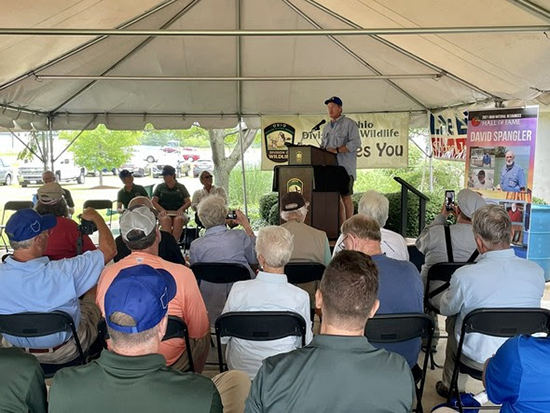
Lt. Governor Husted speaks to a crowd at
Fish Ohio Day.
|
Additionally, on
Thursday, Governor DeWine and Lt. Governor Husted announced the next
launch of the In-Demand Jobs Survey for Ohio businesses to provide
feedback on the state’s In-Demand Jobs List.
“We want Ohio’s businesses to have the qualified workers they
need to thrive, and this survey will help us direct training dollars
into the most needed jobs,” said Governor Mike DeWine. “By working
in partnership with business owners to determine which jobs are most
in-demand, we can strengthen our workforce, create new jobs, and
positively impact the economy of our state.”
The Survey, managed in partnership with the Governor's Office of
Workforce Transformation (OWT), the InnovateOhio Platform and the
Ohio Department of Job and Family Services (ODJFS), creates a simple
user experience and allows businesses to offer input on Ohio’s
current and future in-demand jobs in just minutes.
“This survey helps us ensure that the In-Demand Jobs List is updated
with the most accurate information so students and job seekers know
where to look for the best opportunities,” said Lt. Governor Jon
Husted, who serves as Director of the Governor's Office of Workforce
Transformation. “With insight from the business community, we can
better reflect the needs of employers so that training dollars are
invested towards preparing people for the jobs available in the
workforce now.”
Ohio is required to maintain an up-to-date In-Demand Jobs List that
directs the spending of 85 percent of the Workforce Innovation and
Opportunity Act (WIOA) training funds. Although not required, Ohio
has previously chosen to survey employers to ensure that state
programs meet business needs.
The current survey is open to all registered Ohio businesses,
giving small and large businesses alike the opportunity to have a
voice in how Ohio prepares people for the current workforce.
Businesses can fill out the In-Demand Jobs Survey at
topjobs.ohio.gov/survey.
Ohio’s updated In-Demand Jobs List will be published at the end of
2021.
Governor DeWine made several appointments on Thursday, including to
the The Ohio State University Board of Trustees, Unemployment
Compensation Modernization and Improvement Council, East Cleveland
Financial Planning and Supervision Commission, Board of Nursing, and
more.
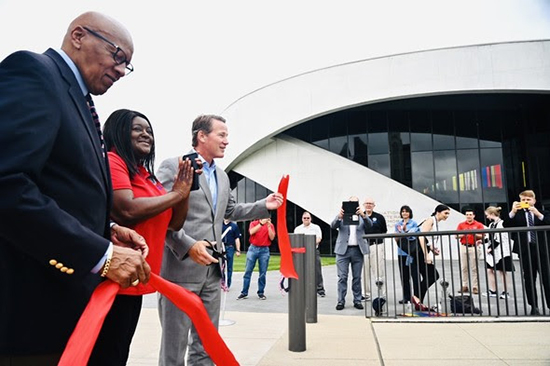
Lt. Governor Husted cuts the
ribbon at the Statement of Support Ceremony hosted by ESGR.
On Friday, Lt. Governor Husted provided remarks at the Statement of
Support Ceremony, hosted by Employers in Support of the Guard and
Reserve (ESGR), at Columbus City Hall, which was followed by a march
to the National Veterans Memorial and Museum. The Statement of
Support is a program designed to encourage employers to act as
advocates for employee participation in the military

The ceremony was followed by a
march to the National Veterans Memorial and Museum.
Also on Friday, Governor DeWine signed House Bill 191 which names
an Ohio bridge in honor of the late Don Manning who served as state
representative from the 59th district. The Don Manning Memorial
Bridge is located on State Route 164 and spans Route 680 in Mahoning
County. The bill was sponsored by State Representative Al Cutrona
(R-Canfield) who was appointed to Rep. Manning’s vacant seat after
his death.
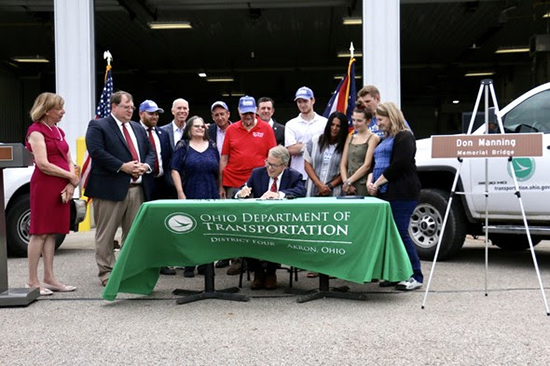
Governor DeWine signs House
Bill 191 naming an Ohio bridge in honor of late State Representative
Don Manning.
Additionally, on Friday, Governor DeWine vetoed Senate Bill 113,
which would have made changes regarding Ohio fireworks safety laws.
The following is the text of the Governor's veto message:
"Pursuant to Article II, Section 16, of the Ohio Constitution, which
states that the Governor may disapprove of any bill, I hereby
disapprove of Substitute Senate Bill 113 and set forth the following
reasons for so doing as it is not in the best interest of Ohioans.
"Substitute Senate Bill 113 (SB 113) would allow the discharge, by
nonprofessionals, of fireworks, including bottle rockets,
firecrackers, and aerial fireworks, at all hours of the day
(twenty-four hours per day) on a minimum of twenty-five (25)
separate holidays in a calendar year (if certain holidays fall on a
Sunday then two days would be allowed for that holiday increasing
the number of allowable days).
"The bill doubles the allowable square footage of fireworks stores,
increasing them from 5,000 sq. feet to 10,000 sq. feet, without
requiring adequate safety features in those stores with enhanced
square footage.
"Since the Scottown, Ohio, (Lawrence County) fireworks store
tragedy in 1996, there have been 2 major studies, one by Battelle
Labs in 2000 and another study by Southwest Research Institute in
2008 (produced for the fireworks industry) to help find better ways
to build and operate fireworks stores. SB 113 does not require
compliance with the safety measures outlined in these studies but
nevertheless doubles the square footage of stores that are selling
these devices to the public.
"SB 113 would be a dramatic change in Ohio law, which would make
Ohio one of the least restrictive states in regard to fireworks
laws.
"For these reasons, this veto is in the public interest."
* Senate Bill 113 Veto Message (signed document)
As of Friday, there have been 1,113,737 confirmed and probable cases
of COVID-19 in Ohio. Additionally, 20,380 confirmed and probable
COVID-19 deaths have occurred. A total of 60,894 people have been
hospitalized, including 8,353 admissions to intensive care units.
CASE DATA/VACCINE INFORMATION
In-depth COVID-19 data for Ohio: coronavirus.ohio.gov.
Ohio's central scheduling system: gettheshot.coronavirus.ohio.gov
Ohio mass vaccination information: coronavirus.ohio.gov/massvaccinationclinics
All vaccine providers: vaccine.coronavirus.ohio.gov
More vaccine information: coronavirus.ohio.gov/vaccine
For more information on Ohio's response to COVID-19, visit
coronavirus.ohio.gov or call 1-833-4-ASK-ODH.
|